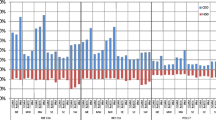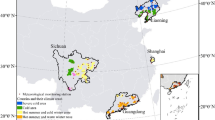Abstract
The description of the relationship between temperature (T) and electricity consumption (EC) is key to improving our understanding of a potential climate change amplification feedback and, thus, energy planning. We sought to characterize the relationship between the EC and daily T of different regions of Argentina and use these historical relationships to estimate expected EC under T future scenarios. We used a time series approach to model EC, removing trends and seasonality and accounting for breaks and discontinuities. EC and T data were obtained from Argentine Wholesale Market Administrator Company and global databases, respectively. We evaluate the T-EC model for the period between 1997 and 2014 and two sub-periods: 1997–2001 and 2011–2014. We use modeled temperature projections for the 2027–2044 period based on the Representative Pathway Concentration 4.5 together with our region-specific T-EC models to predict changes in EC due to T changes. The shape of the T-EC relationships is quite stable between periods and regions but varies according to the temperature gradient. We find large increases in EC in warm days (from 40 to 126 Wh/cap/°C) and a region-specific response to cold days (from flat to steep responses). The T at which EC was at minimum varies between 14 and 20 °C and increase in time as mean daily T also increase. Estimated temperature projections translate into an average increase factor of 7.2 in EC with contrasting relative importance between regions of Argentina. Results highlight potential sensitivity of EC to T in the developing countries.



Similar content being viewed by others
References
Ahuja D, Tatsutani M (2009) Sustainable energy for developing countries. SAPI EN S Surveys and Perspectives Integrating Environment and Society, (2.1)
Apadula F, Bassini A, Elli A, Scapin S (2012) Relationships between meteorological variables and monthly electricity demand. Appl Energy 98:346–356
Argentine National Geographic Institute (2019) Retrieved from: https://www.ign.gob.ar/. Accessed December, 2019
Auffhammer M (2013) Quantifying intensive and extensive margin adaptation responses to climate change: a study of California’s residential electricity consumption. University of California, Berkeley
Auffhammer M, Aroonruengsawat A (2011) Simulating the impacts of climate change, prices and population on California’s residential electricity consumption. Clim Chang 109(1):191–210
Auffhammer M, Mansur ET (2014) Measuring climatic impacts on energy consumption: a review of the empirical literature. Energy Econ 46:522–530
Auffhammer M, Baylis P, Hausman CH (2017) Climate change is projected to have severe impacts on the frequency and intensity of peak electricity demand across the United States. Proc Natl Acad Sci 114(8):1886–1891
Bessec M, Fouquau J (2007) The non-linear link between electricity consumption and temperature: a threshold panel approach. JEL Classification C 33:Q41
Bessec M, Fouquau J (2008) The non-linear link between electricity consumption and temperature in Europe: a threshold panel approach. Energy Econ 30(5):2705–2721
Beyrne G, Malvicino F, Trajtenberg LA (2015) Modelo Estacional de Demanda de Energía Eléctrica. Secretaría de política económica y planificación del desarrollo
Blois JL, Williams JW, Fitzpatrick MC, Jackson ST, Ferrier S (2013) Space can substitute for time in predicting climate-change effects on biodiversity. Proc Natl Acad Sci 110(23):9374–9379
Chévez PJ, Martini I, Discoli C (2018) Análisis territorial y temporal del consumo eléctrico en el sector residencial de Argentina (1995-2014). Cuadernos geográficos de la Universidad de Granada 57(2):162–188
Dale VH, Efroymson RA, Kline KL (2011) The land use–climate change–energy nexus. Landsc Ecol 26(6):755–773
Davis LW, Gertler PJ (2015) Contribution of air conditioning adoption to future energy use under global warming. Proc Natl Acad Sci 112(19):5962–5967
De Cian, E., Lanzi, E., & Roson, R., 2007. The impact of temperature change on energy demand: a dynamic panel analysis
Franco G, Sanstad AH (2008) Climate change and electricity demand in California. Clim Chang 87(1):139–151
Gordon, H. B., Rotstayn, L. D., McGregor, J. L., Dix, M. R., Kowalczyk, E. A., O’Farrell, S. P., & Watterson, I. G., 2002. The CSIRO Mk3 climate system model
Gordon HB, O’Farrell S, Collier M, Dix M, Rotstayn L, Kowalczyk E, Watterson I (2010) The CSIRO Mk3. 5 climate model. CSIRO and Bureau of Meteorology, p 74
Gorelick N, Hancher M, Dixon M, Ilyushchenko S, Thau D, Moore R (2017) Google earth engine: planetary-scale geospatial analysis for everyone. Remote Sens Environ
Gupta E (2016) The effect of development on the climate sensitivity of electricity demand in India. Climate Change Economics 7(02):1650003
IEA (2016) World Energy Outlook 2016 executive summary. International Energy Agency
IEA (2019) Electricity information overview 2019. International Energy Agency
Instituto Nacional de Estadística y Censos-INDEC (2012) Censo nacional de población, hogares y viviendas 2010. censo del bicentenario
Legisa JA, Reali O (1989) Energía: el azar y la necesidad. Ciencia hoy 1(2):46–55
Li Y, Pizer WA, Wu L (2019) Climate change and residential electricity consumption in the Yangtze River Delta, China. Proc Natl Acad Sci 116(2):472–477
Margulis D (2014) Análisis de los determinantes de la demanda residencial de energía eléctrica en Argentina. Tesis de Maestría. Centro de Estudios de la Actividad Regulatoria Energética (CEARE)
Margulis D, Malvicino F, Trajtenberg LA (2016) Impacto de la Temperatura en la Demanda Eléctrica Invernal en Buenos Aires (1998-2015). 1er Seminario A2UE3 (Asociación Argentina Uruguaya de Especialistas en Economía de la Energía)
Margulis D, Malvicino F, Trajtenberg LA (2017) Comparación del impacto de la temperatura en la demanda horaria de electricidad en verano en distintas jurisdicciones argentinas. International Association for Energy Economics
Mastronardi L, Sfeir MA, Sánchez S (2016) La temperatura y su influencia en la demanda de energía eléctrica: Un análisis regional para Argentina usando modelos econométricos. LI Reunión Anual. Asociación Argentina de Economía Política
Mills S, Weiss S, Liang C (2013) VIIRS day/night band (DNB) stray light characterization and correction. In: Earth Observing Systems XVIII, vol 8866. International Society for Optics and Photonics, p 88661P
MINEM, Ministerio de energía de la Nación (2021) Retrieved from: https://www.argentina.gob.ar/economia/energia. Accessed Jan 2021
Moral-Carcedo J, Vicens-Otero J (2005) Modelling the non-linear response of Spanish electricity demand to temperature variations. Energy Econ 27(3):477–494
Moss RH, Edmonds JA, Hibbard KA, Manning MR, Rose SK, Van Vuuren DP, Meehl GA (2010) The next generation of scenarios for climate change research and assessment. Nature 463(7282):747–756
Pachauri RK, Allen MR, Barros VR, Broome J, Cramer W, Christ R, Dubash NK (2014) Climate change 2014: synthesis report. Contribution of Working Groups I, II and III to the fifth assessment report of the Intergovernmental Panel on Climate Change (p. 151). Ipcc
Psiloglou BE, Giannakopoulos C, Majithia S, Petrakis M (2009) Factors affecting electricity demand in Athens, Greece and London, UK: a comparative assessment. Energy 34(11):1855–1863
R Core Team (2018) R: a language and environment for statistical computing. In: R Foundation for statistical computing. Austria. URL, Vienna https://www.R-project.org/
Santamouris M, Cartalis C, Synnefa A, Kolokotsa D (2015) On the impact of urban heat island and global warming on the power demand and electricity consumption of buildings—a review. Energy and Buildings 98:119–124
Shaik S, Yeboah OA (2018) Does climate influence energy demand? A regional analysis. Appl Energy 212:691–703
Shi K, Huang C, Yu B, Yin B, Huang Y, Wu J (2014) Evaluation of NPP-VIIRS night-time light composite data for extracting built-up urban areas. Remote Sensing Letters 5(4):358–366
The World Bank Group (2019) DataBank. Retrieved from: https://data.worldbank.org/ Last access: December, 2019)
Thornton HE, Hoskins BJ, Scaife AA (2016) The role of temperature in the variability and extremes of electricity and gas demand in Great Britain. Environ Res Lett 11(11):114015
Toté C, Patricio D, Boogaard H, van der Wijngaart R, Tarnavsky E, Funk C (2015) Evaluation of satellite rainfall estimates for drought and flood monitoring in Mozambique. Remote Sens 7(2):1758–1776
van Ruijven BJ, De Cian E, Wing IS (2019) Amplification of future energy demand growth due to climate change. Nat Commun 10(1):1–12
Verbesselt J, Hyndman R, Zeileis A, Culvenor D (2010) Phenological change detection while accounting for abrupt and gradual trends in satellite image time series. Remote Sens Environ 114(12):2970–2980
Weedon GP, Balsamo G, Bellouin N, Gomes S, Best MJ, Viterbo P (2014) The WFDEI meteorological forcing data set: WATCH Forcing Data methodology applied to ERA-Interim reanalysis data. Water Resour Res 50. https://doi.org/10.1002/2014WR015638
Wenz L, Levermann A, Auffhammer M (2017) North–south polarization of European electricity consumption under future warming. Proc Natl Acad Sci 114(38):E7910–E7918
Zanek F, Franco J, Mac Gaul de Jorge MI (2019) Forecasting residential electrical consumption for the city of Salta, Argentina. In: XX Simposio Argentino de Inteligencia Artificial (ASAI 2019)-JAIIO 48 (Salta)
Acknowledgements
The authors are grateful to Jorge Siriryi from the Argentine Wholesale Market Administrator Company (CAMMESA acronym in Spanish) for providing the electricity consumption data.
Availability of data, material, and codes
Data for this study are available upon request.
Funding
This research has been financially supported by CONICET (PICT 2017-4528—“Incorporación del nexo Energía-Uso del Suelo-Clima al ordenamiento territorial Argentino”). Propato is supported by a doctoral fellowship from CONICET.
Author information
Authors and Affiliations
Contributions
All authors contributed to the study conception and design. Material preparation, data collection, and analysis were performed by Tamara S. Propato, Diego de Abelleyra, Santiago R. Verón, and María Semmartin. The first draft of the manuscript was written by Tamara S. Propato and all authors commented on previous versions of the manuscript. All authors read and approved the final manuscript.
Corresponding author
Ethics declarations
Conflict of interest
The authors declare no competing interests.
Additional information
Publisher’s note
Springer Nature remains neutral with regard to jurisdictional claims in published maps and institutional affiliations.
Supplementary information
ESM 1
(DOCX 556 kb)
Rights and permissions
About this article
Cite this article
Propato, T.S., de Abelleyra, D., Semmartin, M. et al. Differential sensitivities of electricity consumption to global warming across regions of Argentina. Climatic Change 166, 25 (2021). https://doi.org/10.1007/s10584-021-03129-6
Received:
Accepted:
Published:
DOI: https://doi.org/10.1007/s10584-021-03129-6




